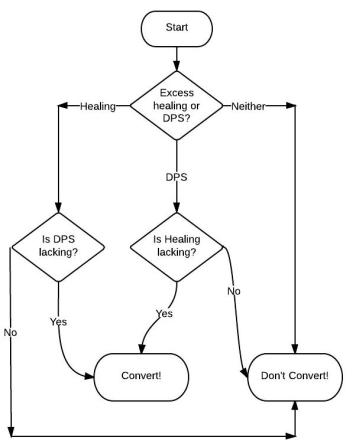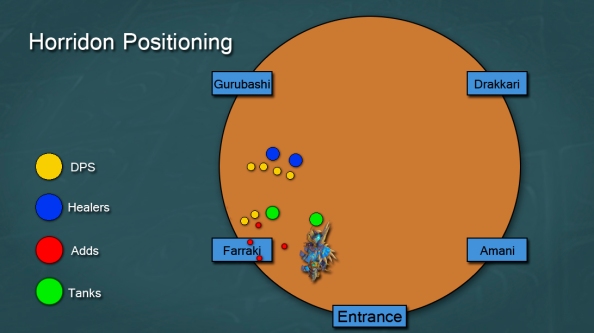Within the context of WoW, utility can be defined as beneficial spells or abilities that serve a special cause. Most of them fall under these major categories:
-crowd control (i.e. Leg Sweep)
-movement/positioning (i.e. Stampeding Roar or Gorefiend’s Grasp)
-interrupts (i.e. Solar Beam)
-raid survivability cooldowns (i.e. Smoke Bomb)
-cleansing/immunities (i.e. Mass Dispel, Divine Shield)
-irregular damage and healing (i.e. Heart of the Wild)
Most of the categories above should be pretty clear cut and simple. However, I want to make a special note about irregular damage and healing. I’m referring mostly to classes who aren’t normally responsible for healing or dealing damage. For example, an Elemental Shaman putting down Healing Rain on the raid would be considered irregular and utility, whereas a Restoration Shaman putting down Healing Rain would not. Thus, Elemental Shamans, who are normally responsible for dealing damage, can be considered to have the utility and the option to assist in healing. This ties in a bit with my post about Raid Role Conversions if you want to read further about that concept.
Take note that DPS cooldowns are not considered utility. There are no points in a fight where using DPS cooldowns (properly) would yield a negative impact, barring special encounter mechanics. However, having the option of manipulating your DPS a certain way for special fights may be considered utility.
Why use utility?
So what is utility good for, anyway? Well, assuming the content you are working on is non-trivial, the DPS/Healing checks should be tight. Utility should be – well – utilized to improve your raid. Sometimes, the benefit you gain isn’t very obvious. You have to view the benefit of utility from an effective standpoint. What does interrupting effectively do? This part is best understood with specific examples.
Scenario: Horridon add phase
The Dinomancer begins channeling a heal on Horridon. Spending resources to interrupt does lower your personal DPS, but that energy/runic power/rage you just spent interrupting just did a massive amount of effective damage because you prevented Horridon from being healed an extra tick.
Scenario: Council of Elders
Sul is chain casting Sand Bolts. Because Sand Bolts are an AoE of 5-yards, that interrupt can end up being a very large amount of effective healing, and often a very worthwhile trade.
Knowing what utility does
Because there are more categories and abilities within than can be feasibly explained, I hope to go over the concept and idea so the implications can be derived by yourself.
- Why use it?
- What does it actually do?
- Evaluate the outcome.
You must first consider the necessity of the ability, and why you’re using it. There has to be a reason you use utility, otherwise in most cases it will either go to waste or have a negative impact on the raid. As such, utility should always be used in response to something. If your tank is struggling on surviving against stunnable adds, or healers are struggling with mana, then consider using an AoE stun.
Second, you must know what the ability effectively does. An AoE stun effectively makes the tank immune to damage from adds for the stun duration. If the adds were otherwise doing 100k DPS on the tank, then your 5 second AoE stun just did 500k healing (or rather, prevented 500k damage). There are other implications too, like preventing them from moving, which may be positive or negative.
Third, re-evaluate if the ability was worthwhile. You may have helped the tank survive by using an AoE stun, but at the cost of extra damage. The bit of survivability help he needed could have come from elsewhere, like an external cooldown that would’ve allowed him to still receive Vengeance. If all better alternatives have been exhausted, then you can say the AoE stun was beneficial. Usually, the best way to determine if something works for your group is just trial and error. Try all options a couple of times and it should be apparent which one is better.
Further examples
While it isn’t feasible for me to go over every category and each example, I would like to mention a few types that I often see underutilized.
Immunities/extreme damage reduction cooldowns:
There are often encounter mechanics that involve applying an otherwise irremovable debuff that can be immuned. Frostbite on Council of Elders for example is one. On heroic, dealing with Frostbite is a major part of the fight. Being able to immune them gives your healers a huge relief, as healing through 300k/second for 30 seconds is not a trivial amount. Similarly, there are often a couple of bosses that do an ability where the raid needs to split the damage. In the last tier, Blade Lord Tayak’s Unseen Strike can be solo-soaked by several classes. Due to the nature of the ability, it poses a huge risk to your raid due to Wind Step ticks. Having players soak it alone not only reduces the amount your raid needs to heal, but also eliminates the risk of people dying. In this tier, solo soaking Static Shock on Lei Shen, especially during transition phases can be very helpful.
Movement/positioning abilities:
Stampeding Roar is a very under-used ability. People often only remember to use it when there’s a specific ability that it’d be perfect for. However, if you’re able to hit multiple people with it during any movement part of the fight, it’s extremely worth it. While the roar may be a personal performance loss, the fact that it’s a pure performance gain for every other person you hit negates that. Most people remember to use it for bosses like Ji-kun, Lei Shen, Durumu, but there’s a very good use for it on every fight, you just have to remember that the utility does translate to an effective performance increase. Similarly, Leap of Faith and Demonic Gateway should also be used on every fight. After trying a new fight a few times, it should be pretty easy to find ways to use these movement skills to your advantage.
Dispels:
There are almost always abilities in every tier that involve a dispellable stun going out on the raid that the healer is responsible for dispelling. In this tier, Twin Consorts’ Slumber Spores is a 5 second sleep. Let’s forget about the 75k/second for 5 seconds the slumber spores does, and focus on the damage/healing loss from the sleep. Giving healers a (very conservative) 2 second reaction/GCD buffer time, said players should not lose too much damage and healing. However, in practice (I’m guilty of this too), debuffs tend to last much longer than that. The effective DPS or, more severely, HPS loss is incredibly high. Consider a hunter sustaining 120k DPS. The extra three seconds he spent in sleep just cost you 360k damage. A healer doing 80k HPS losing three seconds is 240k healing. This might not seem like a lot, but this is just one GCD. Assuming a 1.5s GCD, dispelling a DPS worth 240k DPS for that global and 160k HPS for that global. The utility of dispelling quickly translates to a massive amount of damage/healing loss prevention.
Also not specifically categorized as a dispel, there are unorthodox ways to dispel debuffs that you normally can’t. Almost all negative effects are categorized as either being physical or magical, regardless of what type of debuff it is (Magic, Curse, Disease, etc.) Most physical effects are removed by Hand of Protection. Magical debuffs are removed by AMS, Cloak of Shadows. Divine Shield and Iceblock can remove both. Control impairing effects are removed by abilities like Unbound Will. Movement impairing effects are removed by Stampeding Roar, Hand of Freedom, and Windwalk Totem.
Summary
Using utility abilities to your advantage can improve your raid a vast amount. The amount of abilities Blizzard has put into the game for you to counter boss abilities with is endless. Be it dispels for debuffs, immunities for dangerous abilities, speed boosts, or simple as interrupts. Knowing which to use in what situations is an important factor in ensuring your raid is at its full potential.
I hope this post will help you in your raiding ventures. Until next time!

